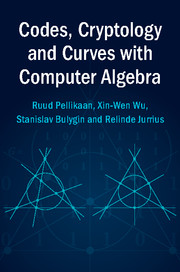Book contents
- Frontmatter
- Dedication
- Contents
- Preface
- 1 Error-correcting Codes
- 2 Code Constructions and Bounds on Codes
- 3 Weight Enumeration
- 4 Cyclic Codes
- 5 Polynomial Codes
- 6 Algebraic Decoding
- 7 Complexity and Decoding
- 8 Codes and Related Structures
- 9 Cryptology
- 10 Gröbner Bases for Coding and Cryptology
- 11 Codes on Curves
- 12 Coding and Cryptology with Computer Algebra
- References
- Index
- References
References
Published online by Cambridge University Press: 26 October 2017
- Frontmatter
- Dedication
- Contents
- Preface
- 1 Error-correcting Codes
- 2 Code Constructions and Bounds on Codes
- 3 Weight Enumeration
- 4 Cyclic Codes
- 5 Polynomial Codes
- 6 Algebraic Decoding
- 7 Complexity and Decoding
- 8 Codes and Related Structures
- 9 Cryptology
- 10 Gröbner Bases for Coding and Cryptology
- 11 Codes on Curves
- 12 Coding and Cryptology with Computer Algebra
- References
- Index
- References
Information
- Type
- Chapter
- Information
- Codes, Cryptology and Curves with Computer Algebra , pp. 565 - 585Publisher: Cambridge University PressPrint publication year: 2017
